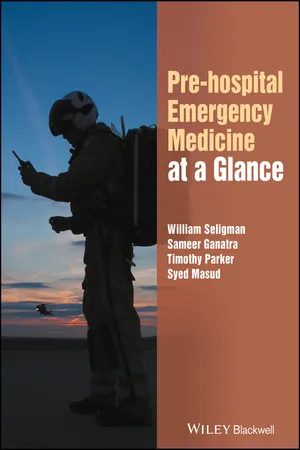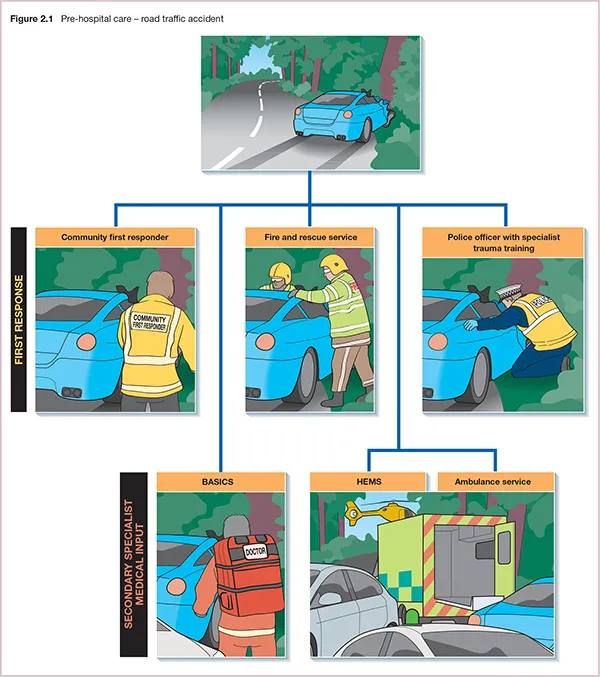
Pre-hospital Emergency Medicine at a Glance
- English
- ePUB (mobile friendly)
- Available on iOS & Android
Pre-hospital Emergency Medicine at a Glance
About this book
British Medical Association Book Award Winner - Young Authors Award of the Year 2018
Pre-hospital Emergency Medicine at a Glance offers healthcare students and trainees the essential theoretical knowledge and practical skills relevant to the provision of immediate care outside of the hospital. This concise text provides information on the principles of managing acutely unwell patients with life-threatening injuries at the scene of their accident, all in highly-illustrated double-page spreads to help explain key messages.
This brand new title:
- Looks at the ways in which pre-hospital care is organised and delivered in the United Kingdom
- Explores some of the most common incidents that pre-hospital care teams attend to, including major trauma as well as cardiac arrests
- Includes an illustrated introduction to some of the many practical procedures pre-hospital care teams must be able to perform including resuscitative thoracotomy and rapid sequence induction of anaesthesia
- Takes into account the multi-disciplinary nature of the specialty
- Features a section on careers within pre-hospital care for doctors and paramedics
Pre-hospital Emergency Medicine at a Glance is the perfect companion for medical students and junior doctors interested in learning more about pre-hospital care, as well as for paramedic students and paramedics who practise in the pre-hospital environment every day.
Frequently asked questions
- Essential is ideal for learners and professionals who enjoy exploring a wide range of subjects. Access the Essential Library with 800,000+ trusted titles and best-sellers across business, personal growth, and the humanities. Includes unlimited reading time and Standard Read Aloud voice.
- Complete: Perfect for advanced learners and researchers needing full, unrestricted access. Unlock 1.4M+ books across hundreds of subjects, including academic and specialized titles. The Complete Plan also includes advanced features like Premium Read Aloud and Research Assistant.
Please note we cannot support devices running on iOS 13 and Android 7 or earlier. Learn more about using the app.
Information
Part 1
Principles of pre-hospital care
Chapters
- History of pre-hospital care
- Pre-hospital care today
- Major trauma pathways in the UK
- Emerging pre-hospital medical care pathways
- Kinematics and mechanism of Injury
- Hazardous materials
- Human factors
- Pre-hospital transport
- Scene safety
1
History of pre-hospital care

The beginning
The catalyst of war
Civilian advances in pre-hospital emergency medicine
Pre-hospital emergency medicine in the UK
2
Pre-hospital care today

Changes in the ambulance service
Table of contents
- Cover
- Title Page
- Copyright
- Preface
- Contributors
- Abbreviations
- Part 1 Principles of pre-hospital care
- Part 2 Initial assessment and management of immediately life-threatening injuries
- Part 3 Special considerations in trauma management
- Part 4 Practical skills in pre-hospital emergency medicine
- Part 5 Management of complex problems
- Part 6 Careers in pre-hospital emergency medicine
- References
- Index
- WILEY END USER LICENSE AGREEMENT